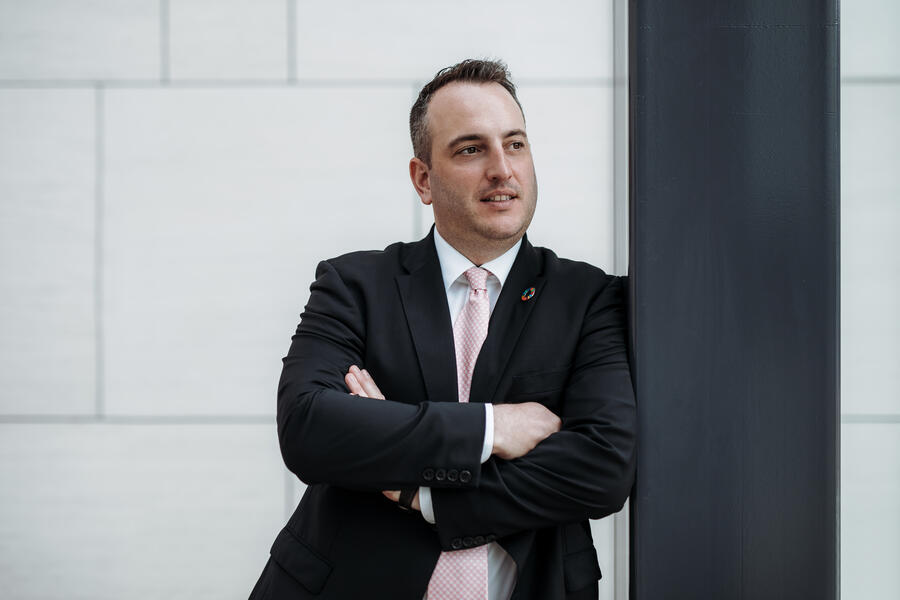At Banque Raiffeisen, we do not like to stand in the middle of the road. This is what emerges from this interview with Jacques Hoffmann, recently appointed to the new position of “Head of ESG” - Environment, Social, Governance - at the Bank, whose mission is to institutionalise the already existing and ambitious ESG objectives of Luxembourg's leading cooperative financial group. We meet him.
After the launch of the first extra-financial report for Banque Raiffeisen in 2021, we focus on the creation of the position of Head of ESG in September 2021. Why did Raiffeisen create such a position?
First of all, it should always be borne in mind that Banque Raiffeisen is a cooperative bank, which has therefore been committed to working solely in the interests of its customers, partners and members in accordance with cooperative values since 1925. So the ESG foundations were already in place.
We therefore felt it was important to build on this by becoming even more mature in the area of sustainability. This should be seen as a marathon rather than a sprint. Implementing ESG in a bank is an incremental exercise. The creation of a Head of ESG position, following the signing of the UNEP FI PRB in 2019 and the publication of our first extra-financial report in early 2021, was the next step in this direction.
How? By equipping ourselves with a strategy and tools to assess and then integrate sustainable development into all of the Bank's activities. We are now at an intermediate stage.
How was the Head of ESG position considered?
The aim was to implement a truly transversal ESG strategy which encompasses the Bank's business lines as well as its products and services.
The position itself is intended to support the development of our bank in terms of ESG issues, so that sustainability becomes a “way of life” for every business and every Raiffeisen staff member.
In real terms, this means making the various departments aware of ESG issues and assisting them in implementing measures, monitoring the results and proposing areas for improvement, if necessary. In this sense, the Head of ESG plays a participatory and unifying role.
You have been working for Banque Raiffeisen for more than three years now. How do you take on the role of “Mr ESG” for the entity?
In a way, I was already the “Mr ESG” of the Bank, because my colleagues and superiors considered me as such, but it was unofficial; it is now official. Personally, I see this job as that of a change manager.
The tasks are substantial, as they go beyond the Bank to include all stakeholders, who need to be made aware of a considerable number of sustainability issues (e.g. risks related to global warming, the circular economy and so on).
How has your career panned out so far?
After finishing my studies in Management at the ICHEC in Brussels, I joined the Luxembourg Stock Exchange where I held various positions which allowed me to familiarise myself with the theme of sustainability within the capital markets, among others through Islamic finance and the Luxembourg Green Exchange (LGX).
When I joined the marketing department of Banque Raiffeisen more than three years ago, I was delighted to see that the tasks I was to perform were also related to sustainability issues.
I coordinated and led the ESG Steering Committee from its inception in 2019. And it was only recently, in September, that I was appointed to the position of Head of ESG.
What are the specifics of Banque Raiffeisen’s ESG strategy?
In line with the seven Sustainable Development Goals (SDGs) which have been retained in our ESG strategy, namely (4) Quality Education, (5) Gender Equality, (8) Decent Work and Economic Growth, (9) Industry, Innovation and Infrastructure, (12) Responsible Consumption and Production, (13) Action on Climate Change and (17) Partnerships to Achieve Goals, we have set ourselves ambitious sustainability targets derived from our priority and sub-themes which have been determined together with our stakeholders. These targets are fully in line with the Bank's business model.
We are constantly striving to be an innovative bank by offering our customers a comprehensive range of sustainable products.
In this regard, I could mention the sustainable Visa credit cards launched in early 2021, which we are using to work with our customers to combat climate change. In practice, we are financing the planting of trees in Luxembourg and Bangladesh, as every 200 transactions made by cardholders will result in a tree being planted.
Another important feature is the “R-Eco personal loan”, which is designed to finance personal ecological projects, such as financing a new ecological car or the energy renovation of a home.
In addition, during 2020, we expanded our offer in the area of ESG investments. Thus, Banque Raiffeisen offers its customers solutions which are part of an ESG approach to give them the opportunity to invest in sustainable products and services supporting the achievement of the United Nations Sustainable Development Goals.
What are the forthcoming sustainability challenges in the financial sector and how are the responses being implemented at Banque Raiffeisen?
Despite the very strong regulations already in place in the banking sector, it is clear that European regulations on sustainable development are not likely to decrease. For a bank of our size, this means massive efforts must be made to adapt and, more importantly, to anticipate.
On the other hand, I would like to emphasise that we also have the advantages of being a human-sized structure, which means we have agility, as well as proximity to the Management Board, which enables us to move forward quickly. In this respect, the signing of the UNEP FI Principles for Responsible Banking in 2019, for example, has enabled us to be proactive in many areas, such as reporting.
I believe that we have nothing to be ashamed of when compared to other operators in the market, and that the extra-financial report which we drew up this year, for the first time, does not lack ambition. This report was a team effort organised around the members of the ESG Steering Committee, in conjunction with an external consultant, an expert in the field. It meets the highest standards in terms of ESG reporting, notably ISO 26000 and GRI, and is therefore the perfect example of the transversal work I mentioned. Indeed, all the topics, facts and figures related to sustainability have been listed, discussed, analysed and faithfully reproduced in this report, which represents a real exercise in transparency.
It is in this direction that we must continue our efforts, being a model of proactivity and not reactivity. So there will still be many challenges as well as opportunities, but we will know how to meet them and to seize them with steadfastness, seriousness and serenity.




